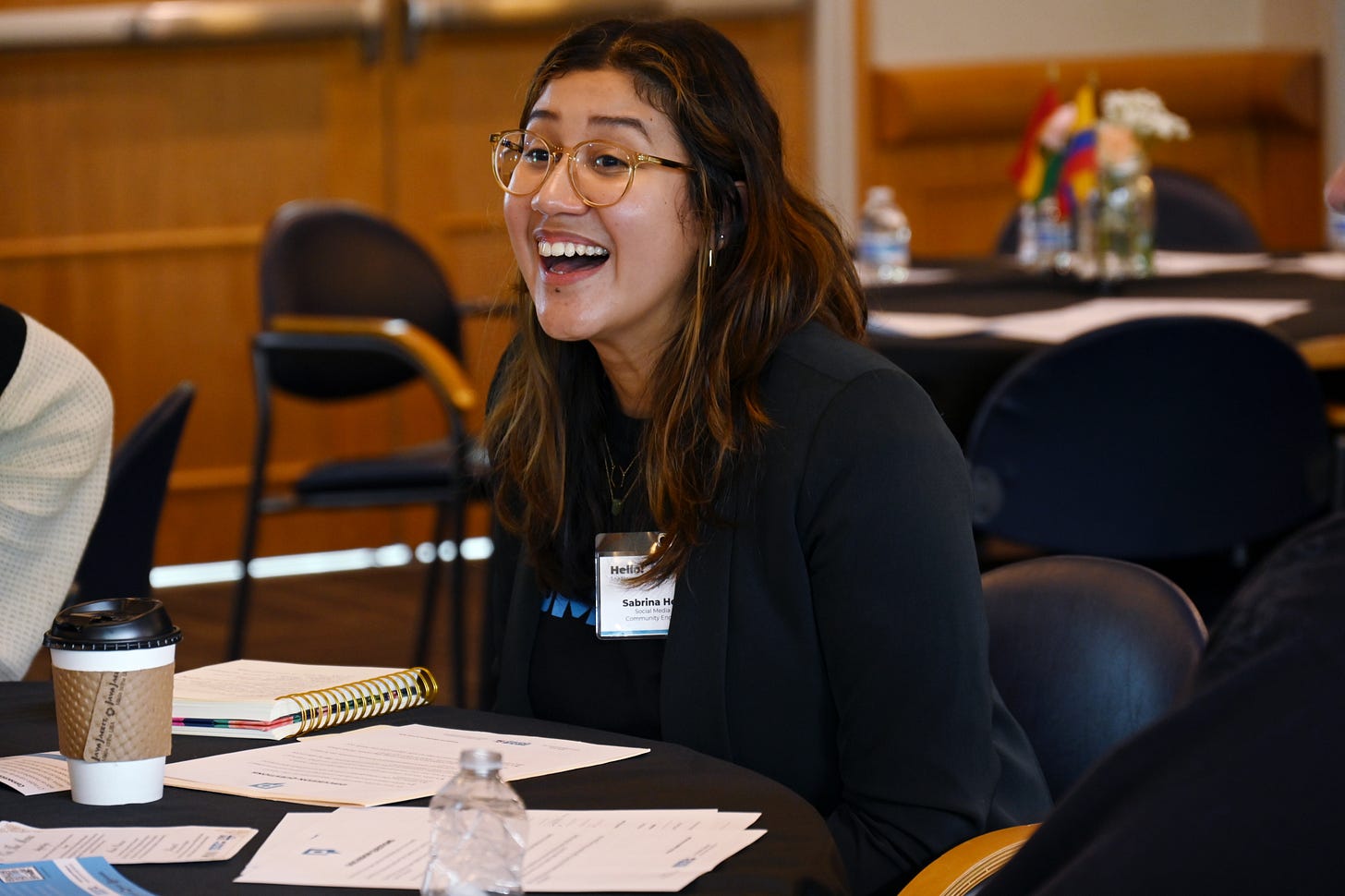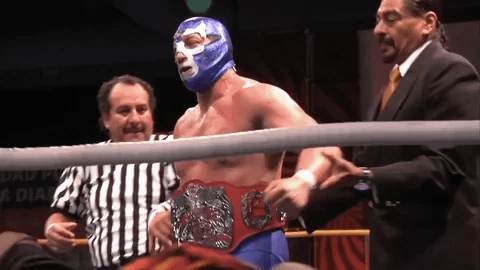Rethinking public media in Latine life
From digital to broadcast, Sabrina Herrera is remaking Connecticut Public's strategy
As the newly announced lead of Connecticut Public’s Latino initiative, Sabrina Herrera is at the forefront of addressing the crucial issue of representation in journalism. Somos Connecticut, that initiative, aims to amplify Latine voices in the state and endeavors to tell our stories authentically. And Herrera’s work in a pivotal election year feels all the more important, as public media aspires to ensure diverse perspectives are included in public discourse.
Connecticut Public is pioneering in creating the position, and Herrera’s approaches to community engagement, such as bilingual programming and digital content strategies tailored to meet the needs of the Latino community, are ones to watch. This OIGO, she joins us to discuss how we build trust and relevance within diverse communities, as well as expand the impact and reach of public media.
As Sabrina says, her story has been both professional and deeply personal. Motivated by her experiences where many voices were missing from the narrative, she has devoted so much of her career to giving those voices a platform. Herrera’s resilience and passion shine brightly, and are sure to inspire you.
Herrera has worked in television production, newspapers, digital, social, community engagement and public media. She has experience leading and building teams, most recently creating Connecticut Public’s first social media team. She also serves on the National Association for Hispanic Journalists (NAHJ) New England Chapter Board. Sabrina performs improv comedy, which led her to saying “yes, and” to hosting the narrative podcast, Generation Barney, coming November 2024. As you’ll learn, she aims to look for the fun in things, and believes you can accomplish anything when working collaboratively as a team. 👇👇👇
You are one of a few people in public media in a position as you are. Please share how you got here.
As I reflect on it, I feel like there were breadcrumbs that led up to this. I was one of those people who always knew they wanted to go into journalism, even since high school. I loved writing from a young age, but high school was where it really cemented for me. And I grew up in a very affluent town, but wasn’t part of that affluent community, which gave me an extra layer of perspective. I felt different from my peers and didn’t fully understand why until I grew older and saw the gaps—economic, wealth and otherwise. This realization motivated me to go into journalism, to give voice to those missing from the stories being told.
Taking a Maynard Institute Fault Lines course early in my journalism career deepened my understanding of my motivations and the history of the industry. I realized that I had been trying to assimilate by tucking away my personal identity among my predominantly white peers, in school and in newsrooms. This newer understanding fueled my passion for diversity, equity and inclusion; and, as I moved through the journalism industry, I embraced every opportunity to learn and grow, even if it wasn’t the job I initially wanted.
Starting as a production assistant in TV, I used the opportunity to learn as much as possible about the newsroom and its workings. During that time, I noticed gaps in local news, particularly around social video, which was just starting to take off on platforms like Facebook. So, I advocated for the creation of social content at a local level and was given the chance to pivot from broadcast to digital. That really set me on a new career path.
When the COVID pandemic hit, I sought different opportunities and eventually became a social media editor at Connecticut Public. That was in 2021. It was a big change for me, because I was the only social editor at the station. My earliest challenge was building a sustainable strategy. Through conversations with my managers, I advocated for finding and testing new workflows and processes and expanding the team, which took three years of effort and adjustments, but we did it. During this time, I also began working on our Latino initiative, collaborating with leadership and local Latino leaders to organize listening sessions and strategize how to better serve the community.
How did that initiative come to be?
It started before my time, with conversations in the newsroom recognizing that we couldn’t wait any longer to address the needs of the Latino community. We gathered local Latino leaders from various sectors and held discussions on what was missing in news coverage. The focus was on finding thematic elements that could move the community forward, not just around potential story threads.
During those discussions, we recognized that news outlets often parachute into communities to report on difficult issues, but miss the full Latino experience. From these conversations with leaders, we began partnering with local organizations and attending existing meetings to understand what the community needed from a local news source.
How did you come to the name of your initiative?
We named it Somos Connecticut to signal that we see and are a part of the community. The name reflects the idea that Latinos here work, live and play in Connecticut, sharing in the joys and challenges of life in the state. It emphasizes that despite our diverse experiences, we are all part of a greater Connecticut and New England community.
What is your day-to-day work like right now?
Since the initiative started, we've made some quick, actionable changes based on our listening sessions. We overhauled our website, added a visible "Latino" button for easy access to news in both English and Spanish, and began developing a content strategy. We’re developing this now.
My role involves many areas, including collaborating across teams to ensure Latino voices are represented in our coverage, even if the story is not exclusively about Latino communities; making connections and building relationships within our local Latino communities; and looking for engagement opportunities, through our content and/or events.
In addition, my role involves taking stock of what we've done, improving it, and planning for sustainable growth. Also, we want to make sure we're incorporating this work into everything we do and ensuring there is representation across all levels, from reporting to leadership.
What is the Latino experience in Connecticut, and how are you addressing the needs?
People have told us they don’t feel seen or heard and want more positive stories that uplift the community. They’re looking for actionable resources, like where to find scholarships or educational opportunities for their children. Bilingual programming for kids is also important, as parents want their children to maintain their heritage while succeeding in an English-speaking world. There’s also skepticism toward mainstream Hispanic news outlets, which often don’t cover the local stories people care about. We see a major opportunity to fill these gaps and create something valuable for the community.
How are you navigating bilingual content in terms of broadcast and digital?
We're still figuring out the broadcast side but recently had a win with a bilingual episode of our talk show, The Wheelhouse. We included bilingual guests, a bilingual phone screener and even promoted the show in English and Spanish. This led to our first-ever call in Spanish during the show, a milestone for us. That caller appreciated the program and encouraged us to do more programming like that.
On the digital side, we work with a translation service and are refining our approach to ensure relevant stories are translated and that we fill information gaps for the community. We hope to eventually have reporters working bilingually and translating content both ways as needed.
What does success look like for the organization?
Success means becoming the go-to news source for Latinos in Connecticut, though we know this won't happen overnight. We want people to turn to us when they have questions and feel connected to us through various platforms. Community engagement is key, and we aim to build strong relationships and connections to show that we’re here for everyone in Connecticut.
How are you thinking about metrics and scale in this initiative, as many organizations struggle with priorities, budgeting and demonstrating impact?
We’re just starting to have those conversations. We're working with our data team to develop a methodology for tracking our progress. We have a Diversity Dashboard, which tracks the demographics of our sources across platforms, and want to eventually have a dedicated Latino initiative dashboard. This will allow us to see our growth over time and ensure we're measuring success accurately. We’re still in the early stages, but we’re laying the groundwork for long-term tracking and success.
Do you have any advice for organizations interested in exploring something like this?
Advocate for this work, even if you encounter push back. Stand your ground and stay mission-driven because this work is so important for underserved communities. Keep pushing forward, knowing that your efforts will make a difference, whether for your organization or for the perspective of just one person.
What have you learned about yourself in this process?
This professional journey has been a personal one too for me. Being the daughter of Colombian immigrants, it has validated who I am and my cultural identity. I've grown more comfortable speaking Spanish and feel grateful to have grown both professionally and personally through this work. This initiative has allowed me to connect with others and with myself in ways I never expected. 🟢
Cafecito: stories to discuss ☕
DEI: If you missed yesterday’s webinar for the DEI Council resource that Paige Robnett and I co-wrote, you can download the paper now at Brevity & Wit. 💜
Major kickoff: The Latino Media Consortium launched this week to support independent Latine/x media, featuring a bevy of heavy hitters in the nonprofit English/Spanish language journalism space. 🤩 Sign up here for updates.
KUUB: Nieman Lab catches up with KUER leaders in Salt Lake City. The licensee has a new bilingual station, KUUB. 🙌 On the ground in Utah, there remain many challenges and questions.
Misinfo: American Press Institute provides an interview on the topic in English and Spanish on the fight against Spanish-language voter targeting. 💣
Elections: The Texas Tribune reports on the GOP’s drive to win Latinos in big cities. Meanwhile, The Hill says the Harris campaign has started a WhatsApp channel to reach Latine voters. 🌵
El radar: try this 📡
Probe feelings around Latinos and firearms. Hispanic voters tend toward wanting more control of guns than most Americans, and Latino USA just asked why. It’s potentially a story to localize. 📝
Ask about quinceañeras. The quinceañera is a common Latin American celebration of a girl’s 15th birthday. Today, as NBC reports, quinceañeras are getting a modern twist. How are parents and daughters recognizing these events near you? 🎇
Dig into health disparities. The Denver Post notes Colorado, Hawaii and New Mexico are the only states where Latinx residents don’t outlive whites. 📄 Even if you are not in these states, healthcare and access are great topics to engage diverse audiences.
Examine Hispanic church expansion. The Christian Standard explored efforts to grow Spanish- and English-language Christian churches in Latino/a neighborhoods. The Latino Christian Movement started in Arkansas, but has expanded — possibly to your state. 🌱
Tell innovative Latine voter stories. 🎀 KGOU localized a national survey with the opinions of Latinx Oklahomans. Elsewhere, New Hampshire Public Radio covers the regional challenges campaigns are facing to reach Hispanics.
The next OIGO arrives Sept. 20. As you re-read Sabrina’s interview, please note that Connecticut Public actually has two multilingual positions open for the Latino Initiative, including Latino Communities Reporter and Senior Manager of Multilingual Digital Marketing. 📈 Yes, you can do this!
Also, you are welcome to buy me a coffee if you like OIGO and want to support. ⚙️







